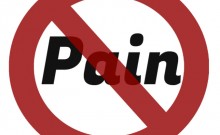In my blog last week we discussed our ability to identify pain in a pose and our capacity to choose a way out of it. After you’ve made the choice to find a way out, you are faced with all kinds of options. First, we are only discussing physical pain here, physical areas that are blocked and could be set free through using good alignment. If you have an experienced teacher, chances are you can discuss your situation with them. Sometimes it’s a quick fix like understanding that the bottom leg in Half Moon has to externally rotate in order to avoid that ‘butt bite’. Of course, knowing this and making it happen are two different things. You start down that path of trying to keep your foot from turning in and you quickly are up against your ability to keep your bottom hip steady and underneath you. Which means you need to make sure the top hip is lifted enough to create space for that bottom hip. On and on there are places to explore and skills to be learned, strength to be gained. You can’t get there though unless you choose to work through and around your level of discomfort.
If you don’t have access to a qualified, experienced teacher then I implore you to take charge of your situation and come out of a pose if it is causing you pain. Too many times I’ve noticed students not wanting to upset the teacher or look ‘different’ than their mat mate and so they are willing to grit teeth and push through. I sigh deeply as I type this. Please reconsider your options and realize that only you wake up in your body the next day. You either treat it well or you deal with the consequences.
In your own practice outside a classroom, you have a fabulous opportunity to explore at your own pace. I know many students find it difficult to have a home practice and I’m not here to discuss this (not in this blog anyway). I will suggest that a home practice is precisely the place to dive deeply into any poses that are causing discomfort. Let’s look at some of the thought process that you might explore.
Listening to your body is really a code word for deeply experiencing the way your body is feeling. This is a presence of mind that clearly states you will keep the lights on inside and explore fully the depths of the sensations. In this endeavor, you stay curious, ask questions and look for solutions to any problems. For example, as you feel the discomfort, qualify it on a scale of 1 – 10. If you are at a 8,9 or a 10 you’ll want to back out immediately from what you are doing. If you can, go back into the pose more slowly and see if you find a place where the discomfort is much lower on the scale. Study the discomfort and figure out where it’s coming from, where it’s attached to and where it is trying to go. Is it isolated to one spot? Does it travel? What happens when you move an adjacent body part one way or the other? What happens when you activate more muscle power? Or lessen muscle power? Is it possible to support part of your body with a prop so you can test out what is contributing and what isn’t?
Your job is to become as familiar as you can with what is going on and how that shifts with different alignment or engagement. Can you find a pattern? Our bodies all have certain tendencies. When you find a misalignment causing a problem for you in one pose, chances are you are likely creating the same pattern of misalignment in a similar pose. Keep track of what gets you out of pain. Chances are you can try the same thing again with success.
Ultimately, we are charged with intimately understanding and taking care of our own bodies. In our practice we can create positive relationships with ourselves listening, learning and trusting our ability to not accept pain and to safely move away from it. Next time you’re up against a sensation you’d rather not put up with, don’t. Decide to treat your glorious body as if it is the only one you have…



